Do you use music to reduce anxiety and stress?
And how does it make you feel afterward?
Calmer? More relaxed?
Yay! Me too!
What kind of music do you choose? Classical? New age? Country? Maybe even a rock ballad?
What if I told you there’s actually music created for this purpose? And believe it or not, it’s intended to do more than conquer anxiety.
Pretty powerful, right?
And from one anxiety-plagued warrior to another, we need to be armed with all the best tools we can find.
That’s why I’m sharing one of my favorites.
In this post, I’ll delve into bilateral music—what it is, how and why I use it, and BONUS, I’ll share my playlist that I use daily!
But first, let’s clear something up. 👌
I’m not a therapist. And I’m not pretending to be. Before listening to any bilateral sounds, read through this entire post to find additional resources.
Guys, if you don’t know already, I suffer from PTSD, anxiety and sometimes, depression.
And this is my honest, authentic opinion on bilateral music: a resource I’ve found exceptionally empowering. And I’m hoping that if I share it, it’ll give others a bit more strength in their journey.
Ready to learn more? Let’s start with the basics.
What is Bilateral Music?
Bilateral music (also referred to as EMDR music, which we’ll talk about in a sec) is music or a series of sounds that travels from left to right, one ear and then the other.
I’ve noticed that composers may choose a particular sound, all of the music, or part of the music to flow from side to side. Regardless of how many or how much sound switches back and forth, it’s enough that our attention is usually called to follow along in the direction of the sound(s).
In order to notice the sound panning from one side to the other side, headphones or earbuds are a must.
OK, so what’s up with the side-to-side shift of the music, and what’s so powerful about it?
How Is it Connected to EMDR and Bilateral Stimulation?
The reason that bilateral music is also referred to as EMDR music is because it comes from and is utilized in EMDR therapy.
What is EMDR? I’ll let the experts explain:
“Eye Movement Desensitization and Reprocessing (EMDR) therapy is an extensively researched, effective psychotherapy method proven to help people recover from trauma and other distressing life experiences, including PTSD, anxiety, depression, and panic disorders.”
– EMDR International Association
And one of the treatments of EMDR is called bilateral stimulation.
And bilateral stimulation, simply put, is what happens when our brain is stimulated on both sides. This stimulation could be visual, tactile or auditory sensations that travel from left to right in a sort of rhythm.
Some examples of bilateral stimulation include:
- tapping (tactile)
- following a finger or light (visual)
- listening to bilateral music or sounds (auditory)
Therapists may use bilateral stimulation to help activate the whole brain and it’s said to strengthen the communication between the brain’s hemispheres.
And in EMDR therapy, it can be used to help people heal and process traumatic events. But, to use bilateral stimulation in this way, it must be done with a mental health professional who is trained in EMDR. So I won’t discuss that approach here.
If you don’t already have one, find an EMDR therapist if you’re interested in bilateral stimulation.
Now let me share how I listen to bilateral music to reduce anxiety.
How Does Bilateral Music Empower Me to Conquer Anxiety?
In addition to helping process upsetting and traumatic events, bilateral sounds have some other serious perks, especially for an anxiety sufferer. These include:
- Less worrying
- More positive feelings
- The ability to see the issue or problem as smaller
- More free flowing thoughts
- Increased relaxation
- Reduced anxiety
- Better sleep
How cool is that?
And honestly, bilateral music helps me:
Find Shelter Within
There’s a lot of crazy in the world. And sometimes, that craziness is so upsetting, I can’t find a refuge. But listening to bilateral music brings my attention inward. Specifically, to my head where I hear the sounds. And in an attempt to follow along with those sounds, I forget what’s going on outside of my head. My problems feel smaller, and less pressing. And my heart and mind bask in the safety I find within, behind the walls that protect me from the outside world.
Improve Focus
Whether I’m upset, stressed, anxious, or my thoughts just feel “stuck,” listening to bilateral music unravels those feelings from my ability to do whatever it is that needs my attention in that moment. Instead of worrying about something else that happened or something that’s coming up, EMDR music allows me to devote more of myself to the task at hand.
Combat Self-Doubt
I can talk myself out of almost any new adventure, challenge or risk. Even if the reward is great. So often, self-doubt decides to make an appearance. To ward off the imposter syndrome, waste time dwelling in self-pity, or wonder if I’m capable of something, I can use bilateral music as a loud interruption to negative self-talk.
Increase Positivity
Segueing from combating self-doubt, EMDR music interrupts many of my negative feelings. And after following the music or sounds from side to side, as I mentioned earlier, my problems feel further away, like they can’t get to me right now. And as I leave them behind, my body feels lighter, my posture improves, breathing deeply gets easier, and thoughts of “this too shall pass” or “things will work out” are invited in.
Reduce Anxiety
I’ve used music to reduce anxiety for years. But after listening to bilateral music, and experiencing the above benefits, my anxiety actually clears—be it for an hour, a day, or even longer. The tight chest, the weight preventing me from taking a deep breath, the jitters and tense shoulders, all of that is relaxed after experiencing the gentle massage the music gives my brain.
Heighten My Well-being
All of the above factors lead to an overall improved sense of self, and well-being. I feel better about myself, my fears and worries, and my ability to cope with those fears. It’s like someone put new batteries in me and I’m able to operate at full power again.
Relax into Sleep
When I have trouble calming down at nighttime, I use mindfulness and meditation to fall asleep. Couple that with EMDR music to reduce anxiety, and it’s a surefire win for me. There are many nights that I listen for an hour or so before I go to bed to come down from the day’s stresses and worries.
How Do I Use Bilateral Music?
First of all, I started using bilateral music after my therapist suggested it. So I recommend talking with your therapist to see if it’s right for you.
Here’s how I listen to it:
- I use headphones. While bilateral music is relaxing no matter how I enjoy it, it’s definitely most effective when wearing headphones or earbuds. It’s too hard to pick up the shift of sounds from left to right otherwise.
- I adjust the volume. Depending on my mood, I adjust the volume where it feels soothing, not intrusive.
- I shut out everything but the music. I take a moment to notice the back and forth motion of the sound. Sometimes I imagine a path or a string that the sound travels along, and as it goes along that path, I follow it and envision it massaging my mind… this is especially helpful in relieving my tension headaches.
- I take deep breaths. After the music plays for a bit, I notice my breath slow. Breathing deeply comes easier the longer I listen.
- I notice changes in my body. My tense shoulders usually drop. My posture improves if I’m sitting up. The weight on my chest lightens. My shoulders relax away from my ears. My jaw unclenches. My eyes may close. And I continue to feel the gentle massage inside my mind from the back and forth motion of the music.
- I don’t set a time limit. I listen to my playlist of EMDR music (which I’ll share below! 👇) for as long as feels appropriate, or until my attention is needed elsewhere (aka, my kids need me 💗).
When Do I Use Bilateral Music?
I use bilateral music several times during the day, but when I use it falls into two categories. (Remember, it shouldn’t be used to process trauma unless an EMDR trained therapist is present, so you won’t see that on this list.)
The first category is when I call all (of most) of my attention to the music. I do this when I:
- Meditate
- Practice mindfulness
- Fall asleep
I’ll stay here for as long as I need, following the side-to-side sounds, and falling further into a relaxed state.
The other category of times I use EMDR music is when I need soothing background noise. If I’m feeling anxious or stressed, but still need to get something done, I’ve found a lot of success playing these tunes. I’ll play bilateral music when I:
- Write
- Brainstorm
- Research
- Answer emails
- Pay bills
- Read
- Paint or Draw
I know it may seem unconventional, but my focus, drive and creativity feels stronger with these sounds spilling out of my headphones—especially if I’m experiencing stress or anxiety. I take breaks every so often and follow the music from left to right for a while before diving back into my work.
Want to Listen to My Best Bilateral Music Playlist?
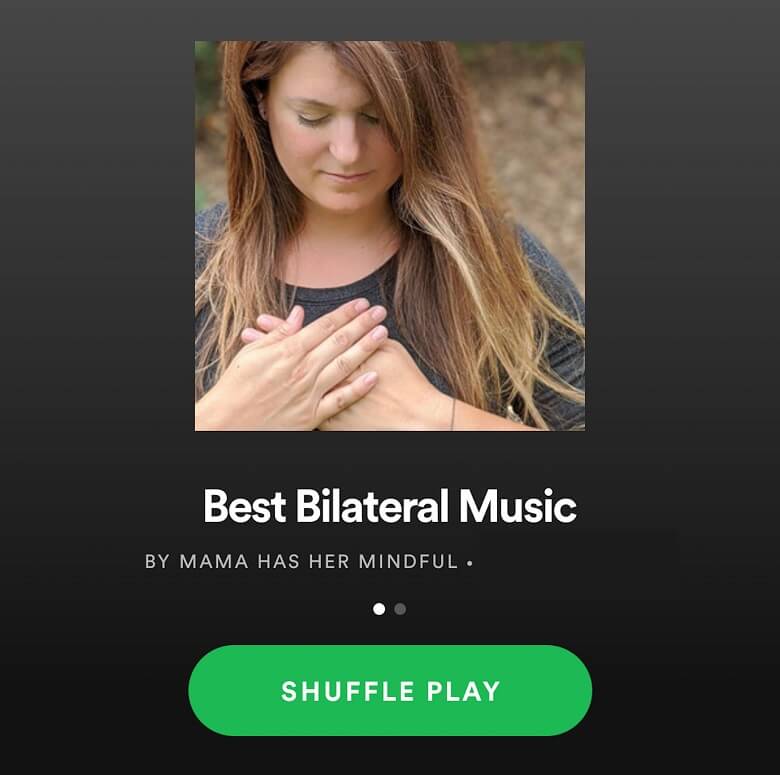
The day my therapist told me I needed to try bilateral music, was the day I created my bilateral and EMDR music playlist. I continue to add to it, too.
It’s currently over 6 hours long and contains 60 songs!
And, since I love to share, I invite you to follow along—for FREE!
Here’s my Best Bilateral Music playlist on Spotify!
And, remember, this type of music isn’t for everyone. So check with your therapist to see if it’s right for you.
How Do You Use Music to Reduce Anxiety?
You’ve read about my experience—now I want to hear from you!
Tell me in the comments below what music helps you relax and conquer anxiety! 🎵👇
And if you want to save this post, don’t forget to Pin it for later. 😘📌
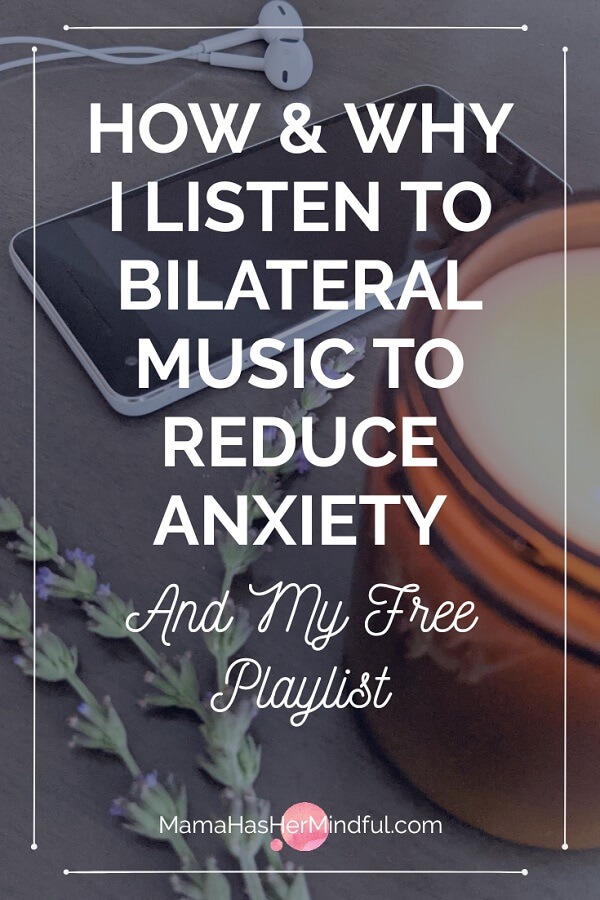
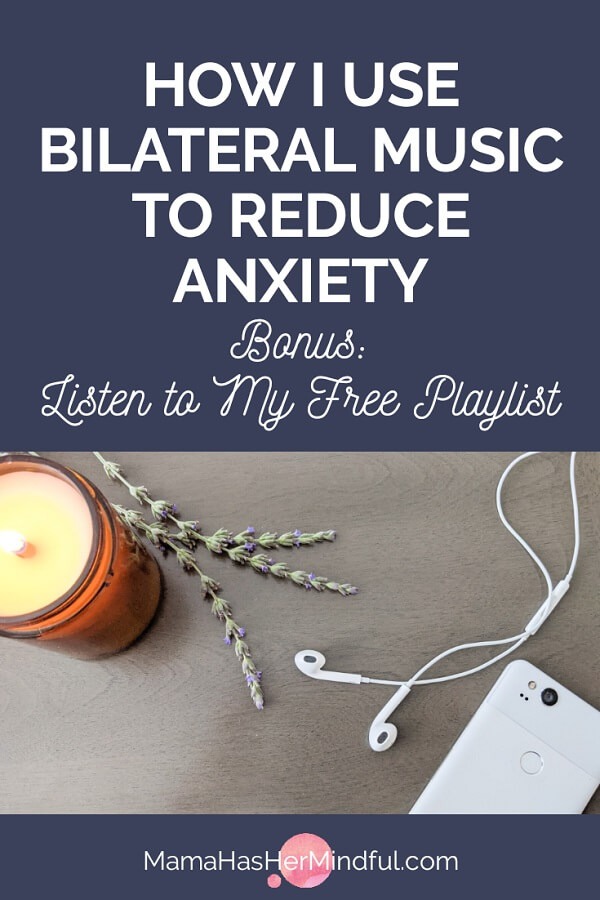

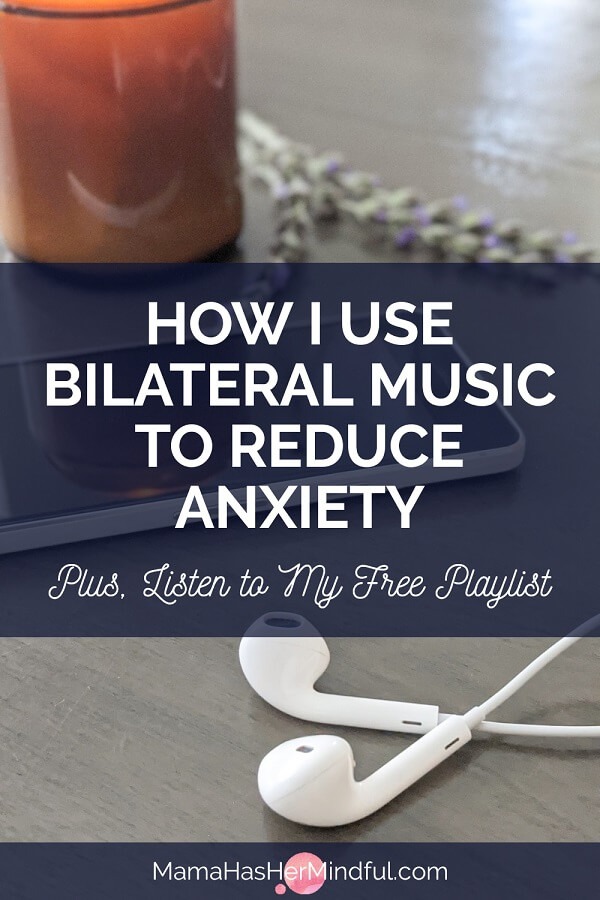
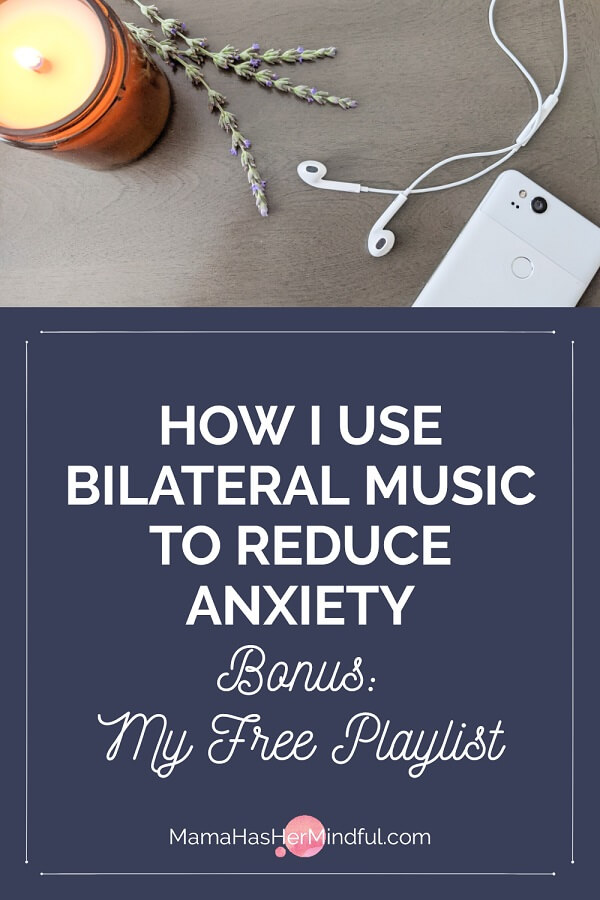

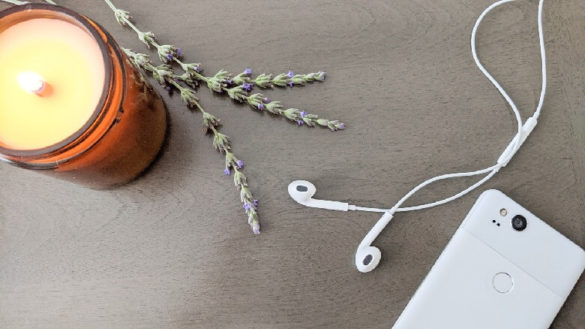
33 comments
I’ve heard others use this, especially for I get to sleep. Try noise cancelling headphones, too!
Yes! It’s a big help with sleep. And headphones are a total must!
What a cool post. I’ve never heard of bilateral music, but I’m really excited to try your playlist and let the magic begin!
Thanks Megan! I hope you find it educational and relaxing!
I love the effect of music on me and the calming effect it has! It really helps with anxiety!
I had not heard of this. Sounds like very helpful info!!
I have heard of this before but haven’t tried it myself. It sounds very intriguing. Anxiety issues are a major epidemic today for sure!
Anxiety is definitely prominent in our world today, and bilateral music can offer so much relief.
I’ve never heard of bilateral music! That’s so cool how it can help like that.
When I was younger I used to fall asleep to music. Now I find that music helps lift my mood is I’m having a hard day. I don’t know what I would do without music.
I can’t live without music. I use bilateral music to help me with anxiety and to help sleep. Love your list!
Thanks for sharing Adrienne. That’s awesome that you use and enjoy bilateral music, too!
Great post! Music is such a great inspiration and helps in so many ways. While I enjoy many different types of music my absolute favorites are actually metal, hard rock, grunge. I’m not sure why but it relaxes me somehow, lol it drives my dance music loving husband nuts.
That’s awesome Alyssa. I love grunge and grew up with it. Don’t use it to relax, but I really enjoy it when I need to clean the house! 😉
I’ve never heard of this process, but now I am so curious!
Well, the way I enjoy music is to put the top down on my convertible, crank up the volume, and sing my lungs out to Motown.
To relax and drift off to sleep – the Calm app.
Lol that’s awesome Suz! And I love the Calm app, too!
Wow! I have never heard of bilateral music before. I always thought this was due to someone’s speaker system rather than the way the music was composed. I rarely listen to music through headphones: maybe I need to give this a try!
I never heard of this for anxiety. Lately mine has been a bit more than usual. I can’t wait to try this!
Interesting! I had not heard of this technique before & so kind of you to share your playlist!
Wow that was really interesting. Thanks
I have huge sleep issues and can’t wait to see if this helps!
I read about EMDR in grad school for mental health and it was difficult but rewarding for those with diagnosis like PTSD. I don’t remember learning about this kind of music though but it makes sense. Thanks for the information.
How fascinating. Never heard of this before. Very interesting concept. Thanks for sharing.
What a great idea. Anxiety is so are to manage.
Anything that reduces anxiety is a good thing in my book.
Thanks for the info! I’ve heard of this but I haven’t tried it. Bilateral music sounds helpful.
I’ve never head of bilateral music before. I’m definitely going to check out your playlist. I usually listed to mellow music because it’s calming esp when I’m working. Thanks for sharing this. I learned something new.
Thanks Jane! I hope you enjoy it. 🙂
I really do appreciate your sharing these techniques that help with anxiety! Thank you for your honesty!
So cool! I’d never heard of bilateral music before or the applications for it, definitely going to give this a try thanks!
I’ve listened to bilateral music quite a bit with great benefits but I particularly enjoy your playlist!! Thanks for sharing!!
Thanks so much Leane for sharing! I’m listening to it right now actually! I keep adding more as I find tracks I like. So glad you’re enjoying it!